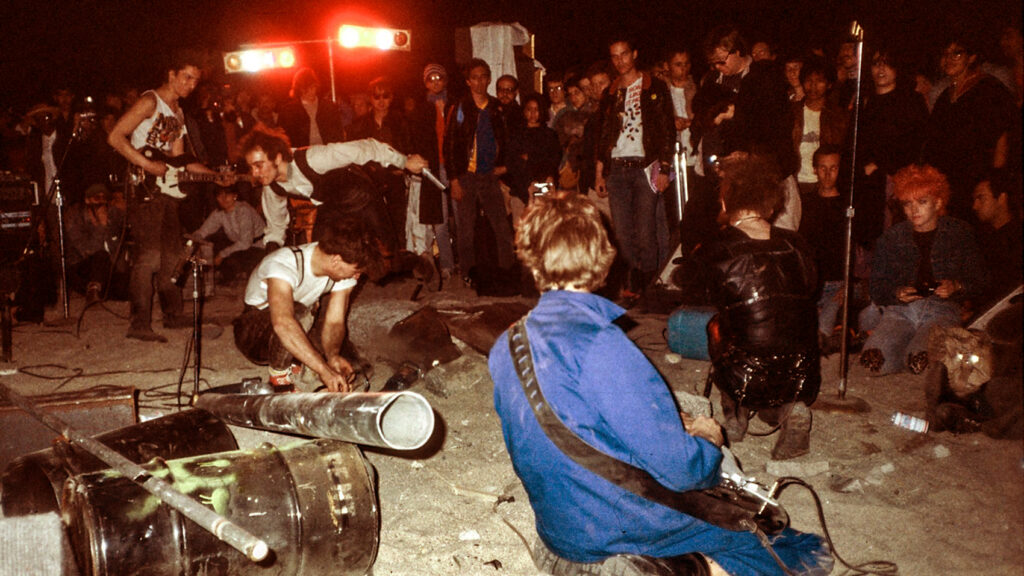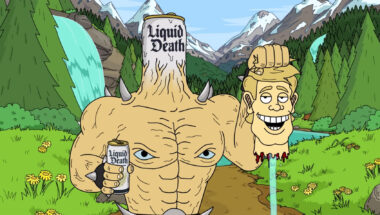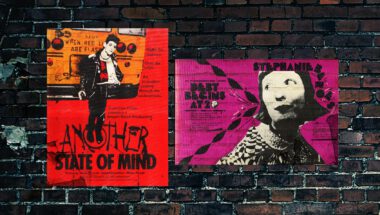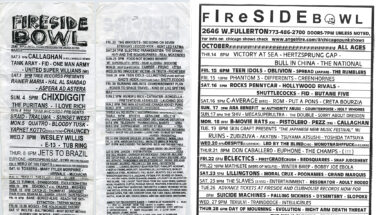Nowadays, it’s easy to take punk/alternative-minded outdoor festivals for granted—but in the 1980s, there was little opportunity for scrappy, weird bands to get any sun. In Los Angeles at that time, in fact, there were few opportunities for punks to play anywhere: LAPD chief/general son of a bitch Daryl Gates famously saw to that, cracking down on the scene at every given opportunity.
Stuart Swezey was in the LA scene during those uncertain times, and he and his friends were looking for a way to enjoy the music they loved without police hassles or Sunset Strip rock bar creepiness. So, working with a crew of friends including Bruce Licher (of cult favorite LA post-punk band Savage Republic) and Mariska Leyssius (photographer and founding member of the band Psi Com, which also featured a pre-Jane’s Addiction Perry Farrell), Swezey rented some school buses, scrapped together a generator and PA, assembled a crew of punks and freaks, and took the music out into middle of the desert.
They called this, and the events that came after, Desolation Center. Most of these events took place in different remote locations in the Southern California desert, but they also took the show to the water, floating the Minutemen, The Meat Puppets, and a smattering of fans out into San Pedro Harbor for their “Joy At Sea” event. Besides the two aforementioned bands, the Desolation Center shows included a host of other bands which time would reveal themselves to be among the most essential of the era, from Sonic Youth to Einstürzende Neubauten to Redd Kross.
For some observers, the settings of the events proved almost as influential as the music: such was the case with Perry Farrell, who would be inspired to found Lollapalooza, and Gary Tovar, whose Goldenvoice company would create Coachella.
A few decades on, Swezey has decided to recount this time in his and his community’s life with a documentary, also called Desolation Center. The resulting film has plenty of the talking heads you’d want to see recounting the events, but it also features copious vintage footage expertly restored to make you feel like you’re there, peaking on acid with Redd Kross under a full moon.
It’s an essential, inspiring story, and one which Swezey hopes will get a new crop of kids operating in unusual ways. “Obviously, there’s a core audience for a doc like this, people who are up on this stuff and want to be brought back to that time. I love, though, when people in their 20s come to the screenings and I talk to them afterwards, because some of them will get really inspired by it,” Swezey said in a recent phone chat. “Things don’t need to be done a certain, codified way; in our era, it was stadium rock, and punk was about shaking that up. If this can reach people and make them do things their own way, I totally support that.”
Below, edited for length and clarity, is the rest of our conversation with Swezey.
You’re in an interesting position as a documentarian, where you were a primary organizing force for the events in question. Was it hard to tell the story while dodging being self-aggrandizing in the process?
It was really hard for me to put myself in the film at all at first. I knew, on some level, that I needed to be, but when we made the first sizzle reel, I wasn’t in it. I hadn’t “interviewed” myself.
When the VICE article came out in 2015, it helped me to see that, yes, this was my story, and that it’d be a better film if I was in it. So, I had to strike a balance between all the other people involved—it was a collective effort, and of course the musicians had to tell their story—but I was the one that was there for all of them. It was kind of my calling, at that point!
I tried to not make it self-aggrandizing. I wanted it to be about that series of events, but also the spirit of that time, after the first wave of punk rock out here on the west coast. I wanted to tell a story about how people were pushing boundaries in all kinds of different forms.
On the West Coast in particular, after that first punk burst, there was something of a psychedelic streak in what was going on, for lack of a less-abused term—not in a retro way, but in that bands and artists seemed to be pushing for something more… transcendent?
Yeah! I had to go back and do some reading just to put it in fuller perspective, which is how (Rip It Up & Start Again and Totally Wired author) Simon Reynolds ended up in the film. He lives about five minutes from my house… he’s in South Pasadena, and I live in Highland Park about two houses from South Pasadena, so I lured him into the film after many nights of beers and talking.
Simon has an essay on SST where he calls it “progressive punk,” and I thought that was really insightful. Those bands were pushing the limits of their musicianship and what could be considered punk, and people like myself, who grew up here, came to expect that from bands, that boundary-pushing. Not to say that people weren’t doing it elsewhere, but it was definitely the vibe here. It wasn’t a straightedge scene at all, but that said, I think everyone was compatible. It was much more about expression and ideas than it was about substances, though substances certainly came into the picture.
I’m sure substances played some factor into why that happened in LA and the Southwest in general, but it’s interesting how that merging of influences manifested in that part of the country.
Yeah. I think when Public Image Limited’s Metal Box came out around 1980, that was a record that was very psychedelic in its own way, and experimental in a studio way that people responded to here. Reynolds noted, though, that bands like Black Flag, the Minutemen, Saccharine Trust, and the Meat Puppets had to do it live on stage instead of the studio, which made for a different sensibility.
But similarly expansive.
And liberating! It expanded what that genre of music could be.
There’s a startling amount of documentation of these shows, considering that they were these largely lawless events that you started when you were 20 years old. There’s a lot of video and audio. Do you think the people documenting it were doing it just for fun, or was it foresight on their part?
Well, looking back, there were some really talented photographers in that scene. If you go back to the early days of LA punk, like with Slash magazine or people like Gary Leonard, there were just so many artistic people. When I started putting the documentary together, Mariska Leyssius was one of the first people I called, to see if she still had pictures from the Desolation Center shows. She had to dig them out of her garage, but when we finally started sharing them, other people started coming forward with their own stuff. Turns out a lot of them had a really good eye!
At the first show, we didn’t have anybody filming, or at least anything that we were able to use. The second show, with Einstürzende Neubauten and Survival Research Laboratories, got a little more advance publicity, so I got approached by people asking to film it. At the time, having access to a video camera was a big deal, and if you knew someone who had one, you’d give them whatever they wanted just to get something documented!
I’d say those people did have some foresight. I knew stuff existed, but it took me coming back around and getting back in touch with people to realize just how much documentation was out there, and how good it was. Just on YouTube, there was great footage of the Joy At Sea show with the Minutemen and the Meat Puppets, but I thought that most of the other footage had been lost. I feel very fortunate that it all exists, and that we were able to get people to share it.
The fact that there was audio was a whole other thing, because it’s easy to have great video with bad audio. Thankfully, Bob Durkee was at all the shows with his Sony Walkman, recording the shows. The end result is kind of a big digital collage of all these elements, but because Tyler (Hubby) is an amazing editor, people have said that they felt like they were there!
I didn’t even know all this stuff existed back when I was doing the shows.
It’s fortunate, and maybe indicative of how media-savvy people are in Los Angeles, that that documentation happened at all.
I don’t know if I’d use the word “media-savvy,” if only just because we were so outside the real Los Angeles media. It was more art students, people like Bruce Licher from Savage Republic. When Bruce was in art school, Chris Burden was his professor! That’s crazy.
There was a definite divide between Hollywood and what we were doing. Maybe someone like Penelope Spheeris (director of The Decline of Western Civilization, Wayne’s World) crossed that gap, but that was kind of miraculous, to go to a movie theater and see something like Decline. Of course, they only showed it a couple times, because the LAPD shut it down quick!
It was more of an arty group—part of what became zine culture and things like that—really doing the documenting. They were all really talented, so it looks great once it all comes together. We did a Desolation Center art show in San Pedro a few years back, and that helped get things together—Laurie Steelink, who runs Cornelius Projects in San Pedro, and Craig Ibarra, who wrote A Wailing of a Town: An Oral History of Early San Pedro Punk and More 1977-1985 and is involved with reissuing a lot of stuff from that scene, helped a lot with that. It revealed a lot more archival stuff. Naomi Petersen’s (late LA punk photographer and SST associate) brother found out about it, and that helped us get some of her photos in the film. The more we revealed, the more we found.
There’s an interesting cross-section of people in that art show. I saw a couple Los Angeles Free Music Society folks…
Yeah! Fredrik Nilsen, one of the founding LAFMS people, did the photo that we used in our movie poster. He was pals with the Einstürzende Neubauten people already when they came out. He’d met them in Berlin and had been corresponding with them.
Speaking of the Neubauten show: I saw in an article that a waiver had gone around for the first Desolation Center show. My question, then: was there a waiver for the Survival Research Laboratories performance? If not, do you regret that there wasn’t?
I think it was actually only the last desert show where we did the waiver thing, and it would have been tongue in cheek if we did. I would have felt weird asking people to sign a waiver when I knew, and they knew, I was taking them out into the desert to watch a bunch of explosions! Neubauten, at their show the night before, had set the show on fire with a Molotov cocktail, so I don’t think I would have asked anybody to sign a waiver. When we did do a waiver, it was a gag that Mariska came up with.
Part of the fun was the risk involved.
Sometimes Survival Research Laboratories would have waivers for some of their street performances, or just signs indicating danger. The idea, though, was that you were putting yourself at risk, and you had to handle yourself accordingly.
You also had to trust that Mark Pauline knew what he was doing. He was this kind of heroic figure, so I just didn’t question him, but looking back on it, he’d also already blown off three of his fingers. The folly of youth! Y’know, though, people kept their distance, and it went surprisingly well. Some people really loved the concept of having these explosions be an opening act for this show.
Well, it’s great that nobody got hurt.
Yes, that would have led to a pretty different outcome, certainly for me personally!
The Desolation Center events, directly or indirectly, inspired all these big events—Lollapalooza, Burning Man, Coachella—that became massive household names, and pretty corporatized. So, multiple choice question: are you a) relieved, b) jealous, c) proud, or d) indifferent that you never cashed in, in that way?
I think I’ve had different reactions at different points in my life. There may have been a moment in my life when I was really broke and was jealous, and there’s certainly an element of relief.
Honestly, though, I didn’t know that Desolation Center had had that impact. I went to Burning Man in 1993 and thought it was cool, back when there was still this utopian idea about it. I didn’t know John Law was involved with it, though I may have known him back then through my co-founding Amok Books. If I’d known back then that what we’d done had inspired Burning Man, I would have been proud, though I’d be completely aghast to be associated with the Burning Man of today!
As far as Lollapalooza, Perry Farrell makes that connection make sense. Perry was a friend and roommate. He played one of the events, and was even a bus monitor at one point! It clearly inspired him.
Now, Gary Tovar, who founded Goldenvoice, was the promoter of the Neubauten show at Perkins Palace in Pasadena the night before the Mojave Auszug show we put on in the desert. He was on the bus the next day, but I had no idea. Many years later, when I was working on the film, I was out with Jordan Schwartz, who used to be part of SST, and he introduced Gary and I. We started talking, and it came out that there was more of a direct connection than I’d thought.
I can tell you, though, that I had no interest in continuing to promote shows when I stopped doing these events. After doing The Gila Monster Jamboree, having Sonic Youth out there with the Meat Puppets and Redd Kross in the desert under the full moon, I just didn’t have any ambition to keep doing it.
So, in short: I’m not necessarily proud of what all those things have become, but I did find it interesting to find out that they had these direct connections to my own life.
It’s strange how things can spin off. Think of what “punk rock” means to a “normal” teenager in 2020. It’s probably grandpa’s music to them, but even if not that, it’s something that can be seen at big festivals. Things are rebellious and boundary-pushing in their time, then once those boundaries are definitively pushed, people can look back on it fondly.
Right. Anything becomes nostalgia if you wait long enough. Even all these decades later, there’s still some kind of vitality in underground punk scenes, where ya pay five bucks to see a bunch of bands, but the spirit of Desolation Center involved the music evolving, as well. We were inspired by the weirder, more avant garde bands like Wire and The Pop Group in the UK, and of course people like Neubauten. The sentiments of punk are still great all these years later, but I do wish more of it was a little more innovative!
Desolation Center makes its Manhattan debut at the IFC Center on Wednesday, February 26. The screening is being presented by Slamdance Film Festival, and will feature a Q&A with Stuart Swezey, Mariska Leyssius, and Lee Ranaldo and Steve Shelley of Sonic Youth, moderated by American Hardcore director Paul Rachman.



